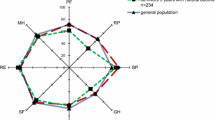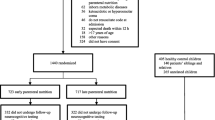Abstract
Objective
To evaluate the long-term outcome of children following admission to a paediatric intensive care unit.
Design
Prospective, long-term follow-up study.
Setting
Sixteen-bed multi-disciplinary paediatric intensive care unit in a free-standing, university, tertiary, teaching hospital.
Patients
All children consecutively admitted to the paediatric intensive care unit from 1st January, 1995, to 31st December, 1995.
Interventions
Outcome was evaluated, by telephone interview, at a median of 3.5 years (range 2.3–6 years) after admission to the intensive care unit using a modification of the Glasgow Outcome Score (GOS) to assess functional outcome and the Health State Utility Index (Mark 1) to assess quality of life.
Measurements and main results
Of the children admitted to the intensive care unit, 83.8% were alive at the time of follow-up. While 10.3% of the survivors had an unfavourable outcome and were likely to live dependent on care, 89.7% had a favourable outcome and were likely to lead an independent existence. Although 16.4% had an unfavourable quality of life, 83.6% of the children survived with a favourable quality of life. At the time of follow-up, 16.2% of the children were dead: 49% died in the intensive care unit, 5% died in hospital and 46% died after discharge from hospital.
Conclusions
The majority of children admitted to a paediatric intensive care unit survive with an excellent functional outcome and quality of life. Long-term outcome assessment provides a basis for observing trends in outcome over time within the same institution.
Similar content being viewed by others
References
Tilford JM, Roberson PK, Lensing SMS, Fiser DH (1998) Differences in pediatric ICU mortality risk over time. Crit Care Med 26:1737–1743
Lansky D, Butler JBV, Waller FT (1992) Using health status measure in the hospital setting: from acute care to 'Outcomes Management'. Med Care 30:MS57–MS73
Epstein AM (1990) The outcomes movement—will it get us where we want to go? N Engl J Med 323:266–270
Butt W, Shann F, Tibballs J, Williams J, Cuddihy L, Blewett L, Farley M (1990) Long–term outcome of children after intensive care. Crit Care Med 18:961–965
Gemke RJBJ, Bonsel GJ, van Vught AJ (1995) Long term survival and state of health after paediatric intensive care. Arch Dis Child 73:196–201
Torres A, Pickert CB, Firestone J, Walker WM, Fiser DH (1997) Long-term functional outcome of inpatient pediatric cardiopulmonary resuscitation. Pediatr Emerg Care 13:369–373
Schlinder MB, Bohn D, Cox, PN, McCrindle BW, Jarvis A, Edmonds J, Barker G (1996) Outcome of out-of-hospital cardiac or respiratory arrest in children. N Engl J Med 335:1473–1479
Carter BG, Taylor A, Butt W (1999) Severe brain injury in children: long-term outcome and its prediction using somatosensory evoked potentials (SEPs). Intensive Care Med 25:722–728
Pollack MM, Rittimann URS Getson PR (1988) Pediatric risk of mortality (PRISM) score. Crit Care Med 16:1110–1116
Australia and New Zealand Intensive Care Society Working Party on Brain Death and Organ Donation (1988) Report. recommendations concerning brain death and organ donation, 2nd edn. The Working Party, March 1988
Torrance GW, Boyle MH, Howood SP (1982) Application of multi-attribute utility theory to measure social preferences for health states. Oper Res 30:1043–1069
Lohr KN (1988) Outcome measurement: concepts and questions. Inquiry 25:37–50
Keith RA (1995) Conceptual basis of outcome measures. Am J Phys Med Rehabil 74:73–90
Greenfield S, Nelson EC (1992) Recent developments and future issues in the use of health status assessment measures in clinical settings. Med Care 30:23–41
Maas AIR, Braakman R, Schouten HJA, Minderhoud JM, van Zomeren AH (1983) Agreement between physicians on assessment of outcome following severe head injury. J Neurosurg 58:321–325
Pantell RH, Lewis CC (1987) Measuring the impact of medical care on children. J Chron Dis 40:99S–108S
Whiteman D, Green A (1997) Wherein lies the truth? Assessment of agreement between parent proxy and child respondents. Int J Epidemiol 26:855–859
Theunissen NC, Vogels TG, Koopman HM, Verrips GH, Zwinderman KA, Verloove-Vanhorick SP, Wit JM (1998) The proxy problem: child report versus parent report in health-related quality of life research. Qual Life Res 7:387–397
Taylor A, Butt W (2000) The evaluation of outcome following paediatric intensive care: the major issues identified. Clin Intensive Care 11:239–244
Keith RA, Granger CV, Hamilton BB, Sherwin FS (1987)The functional independence measure: a new tool for rehabilitation. Adv Clin Rehabil 1:6–18
Hellawell DJ, Signorini DF (1997) The Edinburgh extended Glasgow outcome scale (EEGOS): rationale and pilot studies. Int J Rehabil Res 20:345–354
Lindsay Wilson JT, Pettigrew LEL, Teasdale GM (1998) Structured interviews for the Glasgow Outcome Scale and the Extended Glasgow Outcome Scale: guidelines for their use. J Neurotrauma 15:573–585
Jennett B, Bond M (1975) Assessment of outcome after severe brain damage. Lancet 1:480–484
Feeny D, Furlong W, Barr RD, Torrance GW, Rosenbaum P, Weitzman S (1992) A comprehensive multi-attribute system for classifying the health status of survivors of childhood cancer. J Clin Oncol 10:923–928
Torrance GW, Furlong W, Feeny D, Boyle MH (1992) Provisional health status index for the Ontario Health Survey. Final report submitted to Statistics Canada. (Contract 44400900187) Hamilton, Ontario: Centre for Health Economics and Policy Analysis, McMaster University
Fitzpatrick R, Fletcher A, Gore S, Jones D, Spiegelhalter D, Cox D (1992) Quality of life measure in health care. Part I: Applications and issues in assessment. BMJ 305:1074–1077
Author information
Authors and Affiliations
Corresponding author
Rights and permissions
About this article
Cite this article
Taylor, A., Butt, W. & Ciardulli, M. The functional outcome and quality of life of children after admission to an intensive care unit. Intensive Care Med 29, 795–800 (2003). https://doi.org/10.1007/s00134-003-1690-6
Received:
Accepted:
Published:
Issue Date:
DOI: https://doi.org/10.1007/s00134-003-1690-6




